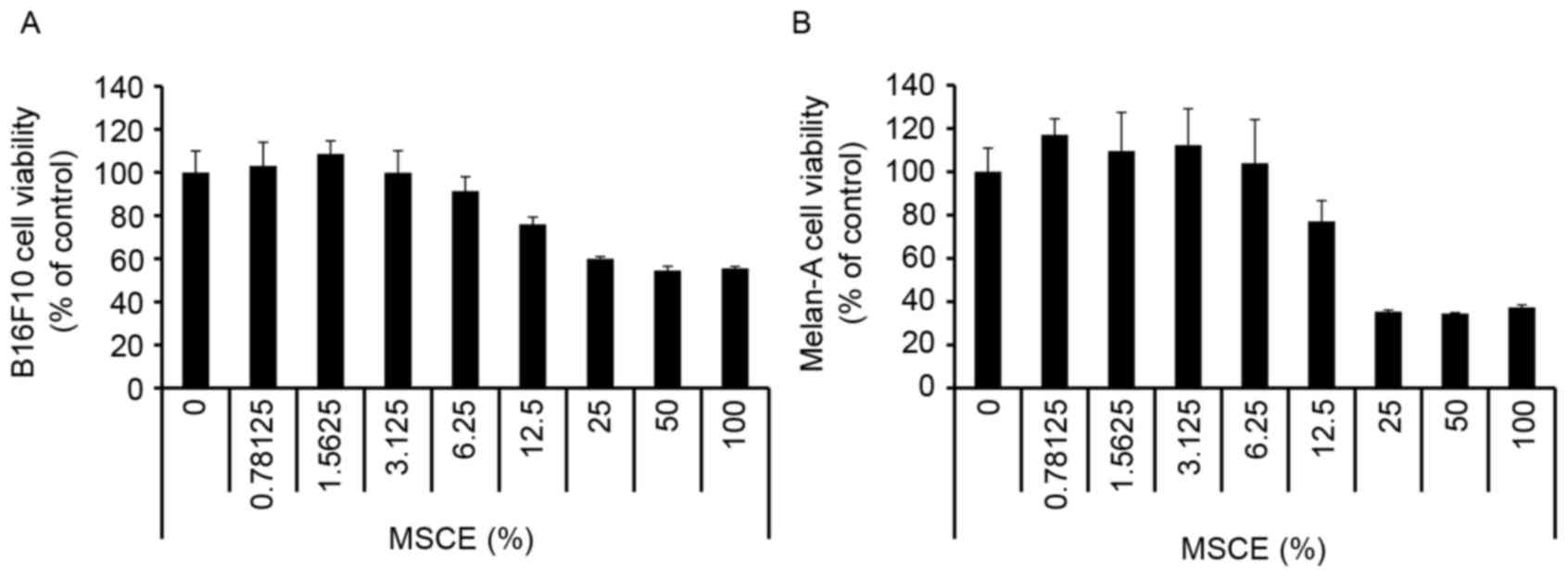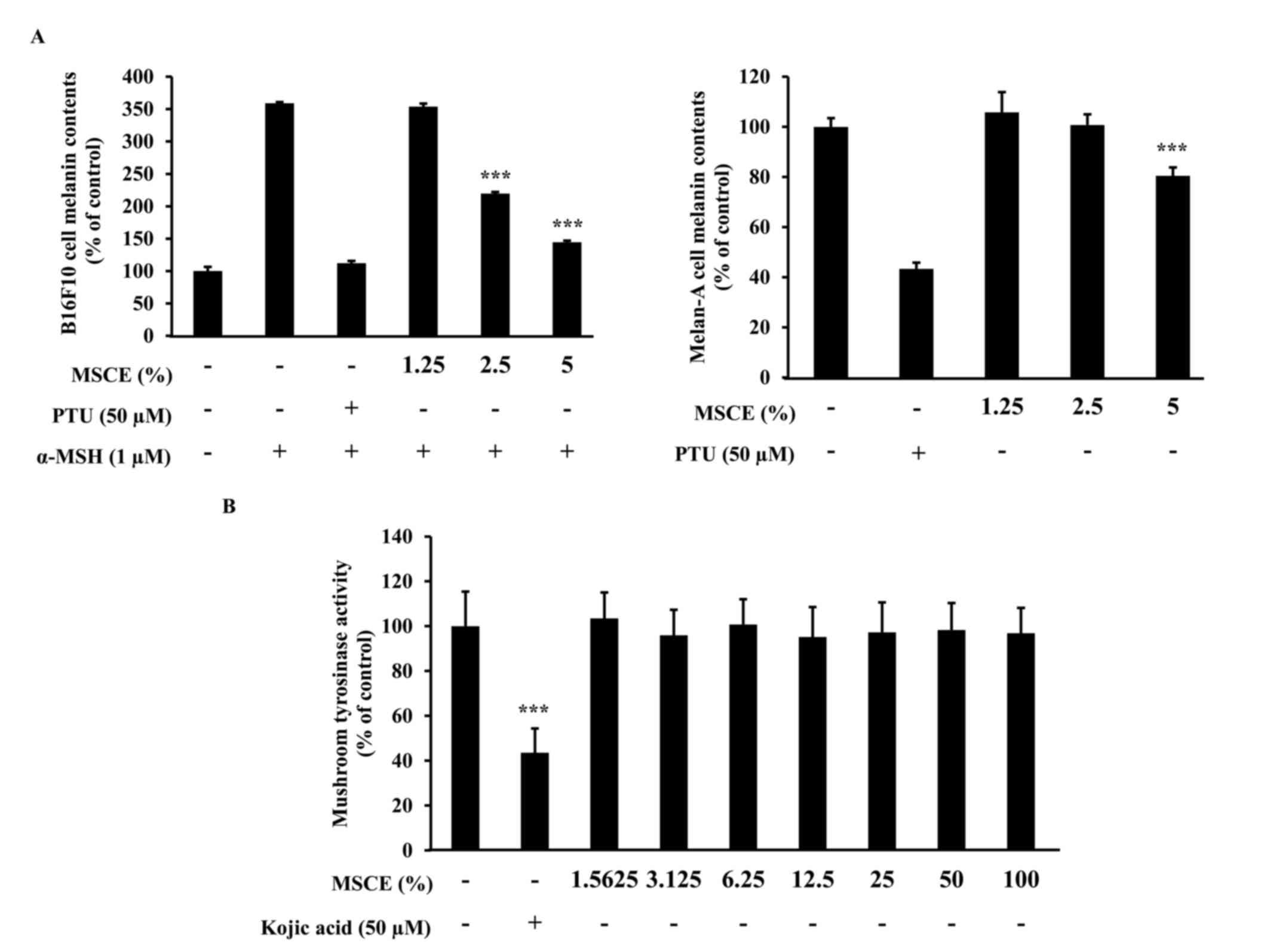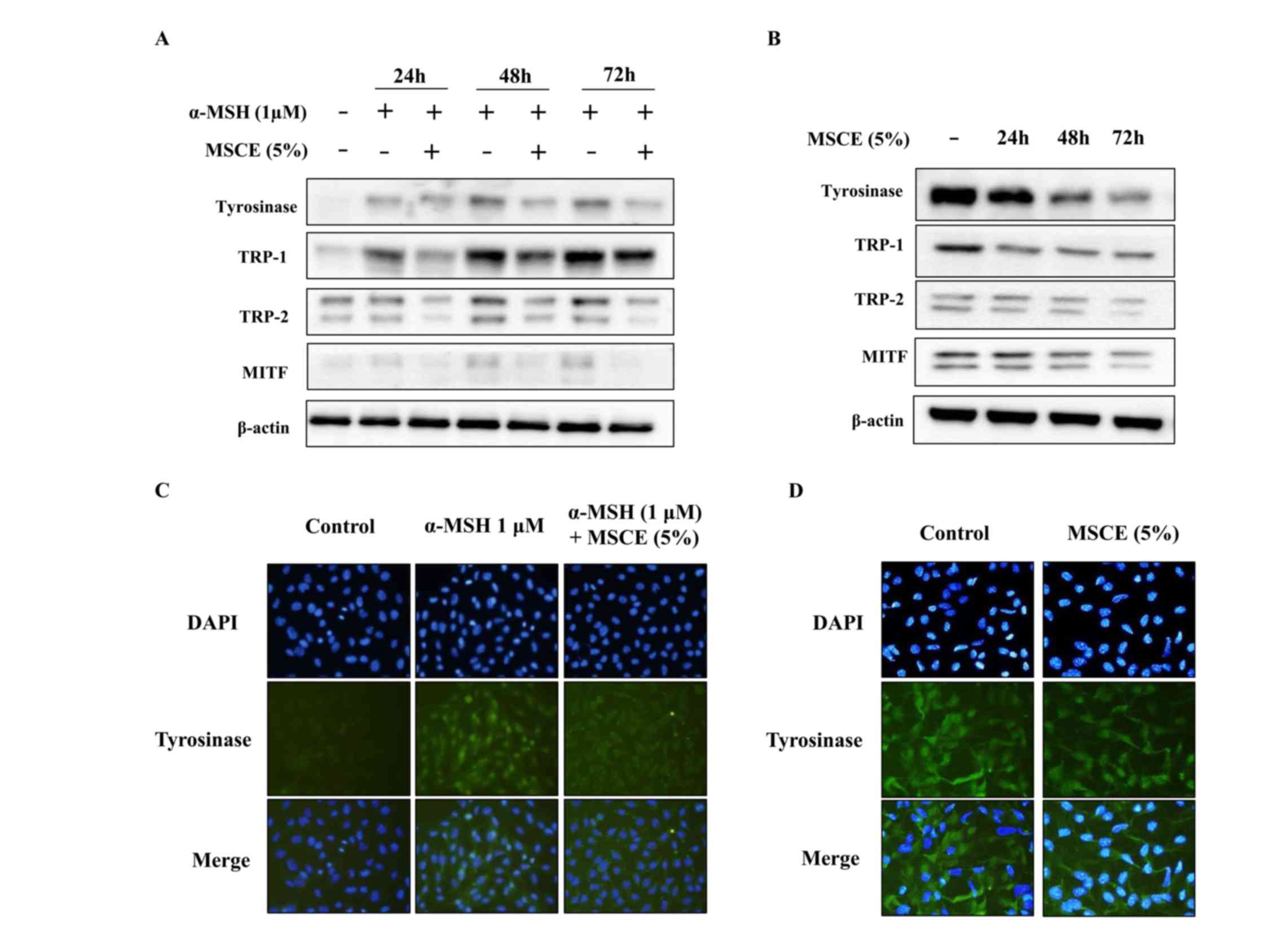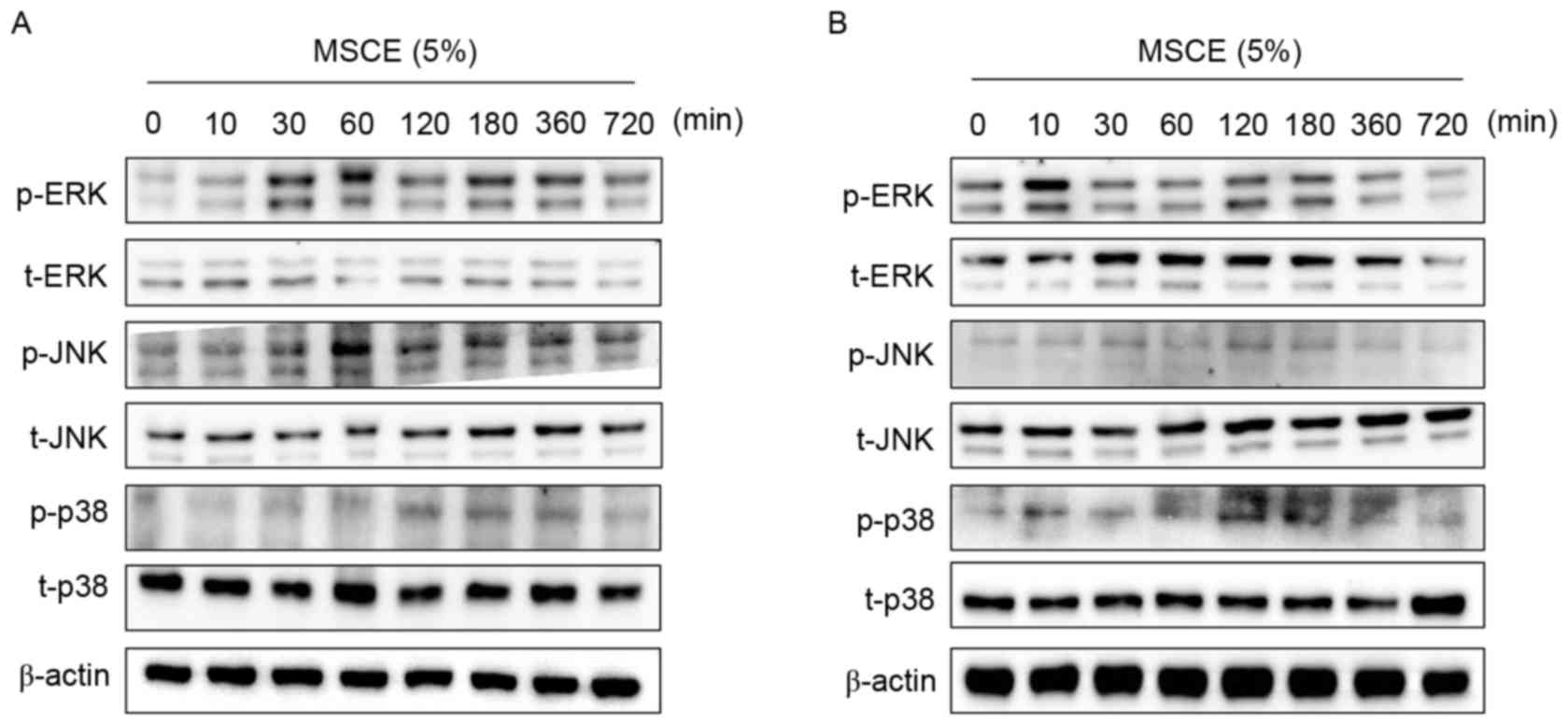|
1
|
D'Mello SA, Finlay GJ, Baguley BC and
Askarian-Amiri ME: Signaling pathways in melanogenesis. Int J Mol
Sci. 17:pii: E11442016. View Article : Google Scholar
|
|
2
|
Ichihashi M and Ando H: The maximal
cumulative solar UVB dose allowed to maintain healthy and young
skin and prevent premature photoaging. Exp Dermatol. 23 Suppl
1:S43–S46. 2014. View Article : Google Scholar
|
|
3
|
Sklar LR, Almutawa F, Lim HW and Hamzavi
I: Effects of ultraviolet radiation, visible light, and infrared
radiation on erythema and pigmentation: A review. Photochem
Photobiol Sci. 12:54–64. 2013. View Article : Google Scholar : PubMed/NCBI
|
|
4
|
Gange RW: Comparison of pigment responses
in human skin to UVB and UVA radiation. Prog Clin Biol Res.
256:475–485. 1988.PubMed/NCBI
|
|
5
|
Huang HC, Hsieh WY, Niu YL and Chang TM:
Inhibitory effects of adlay extract on melanin production and
cellular oxygen stress in B16F10 melanoma cells. Int J Mol Sci.
15:16665–16679. 2014. View Article : Google Scholar : PubMed/NCBI
|
|
6
|
Ma H, Xu J, DaSilva NA, Wang L, Wei Z, Guo
L, Johnson SL, Lu W, Xu J, Gu Q and Seeram NP: Cosmetic
applications of glucitol-core containing gallotannins from a
proprietary phenolic-enriched red maple (Acer rubrum) leaves
extract: Inhibition of melanogenesis via down-regulation of
tyrosinase and melanogenic gene expression in B16F10 melanoma
cells. Arch Dermatol Res. 309:265–274. 2017. View Article : Google Scholar : PubMed/NCBI
|
|
7
|
Camacho-Hübner A and Beermann F: Cellular
and molecular features of mammalian pigmentation-tyrosinase and
TRP. Pathol Biol (Paris). 48:577–583. 2000.(In French). PubMed/NCBI
|
|
8
|
Ishii N, Ryu M and Suzuki YA: Lactoferrin
inhibits melanogenesis by down-regulating MITF in melanoma cells
and normal melanocytes. Biochem Cell Biol. 95:119–125. 2017.
View Article : Google Scholar : PubMed/NCBI
|
|
9
|
Tagashira H, Miyamoto A, Kitamura S,
Tsubata M, Yamaguchi K, Takagaki K and Imokawa G: UVB stimulates
the expression of endothelin B receptor in human melanocytes via a
sequential activation of the p38/MSK1/CREB/MITF pathway which can
be interrupted by a french maritime pine bark extract through a
direct inactivation of MSK1. PLoS One. 10:e01286782015. View Article : Google Scholar : PubMed/NCBI
|
|
10
|
Han JS, Sung JH and Lee SK:
Antimelanogenesis activity of hydrolyzed ginseng extract (GINST)
via Inhibition of JNK Mitogen-activated protein kinase in B16F10
Cells. J Food Sci. 81:H2085–H2092. 2016. View Article : Google Scholar : PubMed/NCBI
|
|
11
|
Huang HC, Wei CM, Siao JH, Tsai TC, Ko WP,
Chang KJ, Hii CH and Chang TM: Supercritical fluid extract of spent
coffee grounds attenuates melanogenesis through downregulation of
the PKA PI3K/Akt, and MAPK signaling pathways. Evid Based
Complement Alternat Med. 2016:58602962016. View Article : Google Scholar : PubMed/NCBI
|
|
12
|
Fu YT, Lee CW, Ko HH and Yen FL: Extracts
of Artocarpus communis decrease α-melanocyte stimulating
hormone-induced melanogenesis through activation of ERK and JNK
signaling pathways. ScientificWorldJournal. 2014:7243142014.
View Article : Google Scholar : PubMed/NCBI
|
|
13
|
Hseu YC, Cheng KC, Lin YC, Chen CY, Chou
HY, Ma DL, Leung CH, Wen ZH and Wang HM: Synergistic effects of
linderanolide B Combined with Arbutin, PTU or kojic acid on
tyrosinase inhibition. Curr Pharm Biotechnol. 16:1120–1126. 2015.
View Article : Google Scholar : PubMed/NCBI
|
|
14
|
Desmedt B, Courselle P, de Beer JO,
Rogiers V, Grosber M, Deconinck E and De Paepe K: Overview of skin
whitening agents with an insight into the illegal cosmetic market
in Europe. J Eur Acad Dermatol Venereol. 30:943–950. 2016.
View Article : Google Scholar : PubMed/NCBI
|
|
15
|
Wang X, Wang L, Che J, Li Z, Zhang J, Li
X, Hu W and Xu Y: Improving the quality of Laminaria japonica-based
diet for Apostichopus japonicus through degradation of its algin
content with Bacillus amyloliquefaciens WB1. Appl Microbiol
Biotechnol. 99:5843–5853. 2015. View Article : Google Scholar : PubMed/NCBI
|
|
16
|
Liu X, Sun Z, Zhang M, Meng X, Xia X, Yuan
W, Xue F and Liu C: Antioxidant and antihyperlipidemic activities
of polysaccharides from sea cucumber Apostichopus japonicus.
Carbohydr Polym. 90:1664–1670. 2012. View Article : Google Scholar : PubMed/NCBI
|
|
17
|
Gao F, Li F, Tan J, Yan J and Sun H:
Bacterial community composition in the gut content and ambient
sediment of sea cucumber Apostichopus japonicus revealed by 16S
rRNA gene pyrosequencing. PLoS One. 9:e1000922014. View Article : Google Scholar : PubMed/NCBI
|
|
18
|
Himaya SW, Ryu B, Qian ZJ and Kim SK: Sea
cucumber, Stichopus japonicus ethyl acetate fraction modulates the
lipopolysaccharide induced iNOS and COX-2 via MAPK signaling
pathway in murine macrophages. Environ Toxicol Pharmacol. 30:68–75.
2010. View Article : Google Scholar : PubMed/NCBI
|
|
19
|
Zohdi RM, Zakaria ZA, Yusof N, Mustapha NM
and Abdullah MN: Sea cucumber (Stichopus hermanii) based hydrogel
to treat burn wounds in rats. J Biomed Mater Res B Appl Biomater.
98:30–37. 2011. View Article : Google Scholar : PubMed/NCBI
|
|
20
|
Bennett DC, Cooper PJ and Hart IR: A line
of non-tumorigenic mouse melanocytes, syngeneic with the B16
melanoma and requiring a tumour promoter for growth. Int J Cancer.
39:414–418. 1987. View Article : Google Scholar : PubMed/NCBI
|
|
21
|
Shin HJ, Oh CT, Kwon TR, Beak HS, Joo YH,
Kim JH, Lee CS, Lee JH, Kim BJ, Shin SS and Park ES: A novel
adamantyl benzylbenzamide derivative, AP736, inhibits melanogenesis
in B16F10 mouse melanoma cells via glycogen synthase kinase 3β
phosphorylation. Int J Mol Med. 36:1353–1360. 2015.PubMed/NCBI
|
|
22
|
Oh CT, Lee D, Koo K, Lee J, Yoon HS, Choi
YM, Kwon TR and Kim BJ: Superoxide dismutase 1 inhibits
alpha-melanocyte stimulating hormone and ultraviolet B-induced
melanogenesis in murine skin. Ann Dermatol. 26:681–687. 2014.
View Article : Google Scholar : PubMed/NCBI
|
|
23
|
Casanola-Martin GM, Le-Thi-Thu H,
Marrero-Ponce Y, Castillo-Garit JA, Torrens F, Rescigno A, Abad C
and Khan MT: Tyrosinase enzyme: 1. An overview on a pharmacological
target. Curr Top Med Chem. 14:1494–1501. 2014. View Article : Google Scholar : PubMed/NCBI
|
|
24
|
Smit N, Vicanova J and Pavel S: The hunt
for natural skin whitening agents. Int J Mol Sci. 10:5326–5349.
2009. View Article : Google Scholar : PubMed/NCBI
|
|
25
|
Lee WJ, Bang S, Chung BY, Jung H, Oh ES
and Chang SE: Inhibitory effects of N,N,N-trimethyl
phytosphingosine-iodide on melanogenesis via ERK
activation-mediated MITF degradation. Biosci Biotechnol Biochem.
80:121–127. 2015. View Article : Google Scholar : PubMed/NCBI
|
|
26
|
Ebanks JP, Wickett RR and Boissy RE:
Mechanisms regulating skin pigmentation: The rise and fall of
complexion coloration. Int J Mol Sci. 10:4066–4087. 2009.
View Article : Google Scholar : PubMed/NCBI
|
|
27
|
Desmedt B, Rogiers V, Courselle P, de Beer
JO, De Paepe K and Deconinck E: Development and validation of a
fast chromatographic method for screening and quantification of
legal and illegal skin whitening agents. J Pharm Biomed Anal.
83:82–88. 2013. View Article : Google Scholar : PubMed/NCBI
|
|
28
|
Kwak JY, Seok JK, Suh HJ, Choi YH, Hong
SS, Kim DS and Boo YC: Antimelanogenic effects of luteolin
7-sulfate isolated from Phyllospadix iwatensis Makino. Br J
Dermatol. 175:501–511. 2016. View Article : Google Scholar : PubMed/NCBI
|
|
29
|
Yoon WJ, Kim MJ, Koh HB, Lee WJ, Lee NH
and Hyun CG: Effect of Korean Red Sea Cucumber (Stichopus
japonicus) on Melanogenic Protein Expression in Murine B16
Melanoma. Int J Pharmacol. 6:37–42. 2010. View Article : Google Scholar
|
|
30
|
Slominski A, Moellmann G and Kuklinska E:
L-tyrosine, L-dopa and tyrosinase as positive regulators of the
subcellular apparatus of melanogenesis in Bomirski Ab amelanotic
melanoma cells. Pigment Cell Res. 2:109–116. 1989. View Article : Google Scholar : PubMed/NCBI
|
|
31
|
Yanase H, Ando H, Horikawa M, Watanabe M,
Mori T and Matsuda N: Possible involvement of ERK 1/2 in
UVA-induced melanogenesis in cultured normal human epidermal
melanocytes. Pigment Cell Res. 14:103–109. 2001. View Article : Google Scholar : PubMed/NCBI
|
|
32
|
Alam MB, Seo BJ, Zhao P and Lee SH:
Anti-Melanogenic activities of heracleum moellendorffii via
ERK1/2-Mediated MITF Downregulation. Int J Mol Sci. 17:pii:
e18442016. View Article : Google Scholar
|














